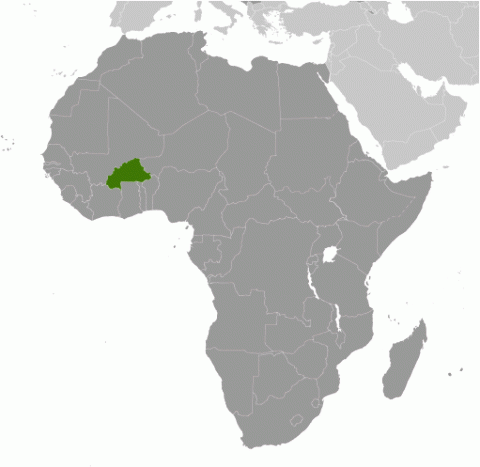Child Labor and Forced Labor Reports
Burkina Faso


Moderate Advancement
In 2024, Burkina Faso made moderate advancement in efforts to eliminate the worst forms of child labor. A new mining code was adopted with key provisions banning child labor at mine sites, and the Ministry of Civil Service, Labor, and Social Protection published its National Child Labor Survey of 2022 and the 2023 Statistical Report. Birth certificates were also issued to 14,000 vulnerable children, enabling access to schooling and services, and 12 child protection networks were established, including a cross‑border network with Côte d’Ivoire. However, the government lacked financial resources for the enforcement of child labor laws and did not release information on its criminal law enforcement efforts, including whether investigations into suspected cases of the worst forms of child labor were conducted, prosecutions initiated, or perpetrators convicted. Finally, social programs to address child labor are insufficient, including programs to address child labor in cotton production, gold mining, and the commercial sexual exploitation of girls.
| Children | Age | Percent and Population |
|---|---|---|
| Working | 5 to 14 | 36.9% (2,190,780) |
| Boys | 32.5% | |
| Girls | 41.5% | |
| Urban | 20.2 | |
| Rural | 42.5 | |
| Hazardous Work by Children | 15 to 17 | 4.1% (54,313) |
| Boys | 5.6% | |
| Girls | 2.7% | |
| Urban | 2.3% | |
| Rural | 4.9% | |
| Attending School | 5 to 14 | Unavailable |
| Combining Work and School | 7 to 14 | 13.7% |
| Sector/Industry | Percent of Population |
|---|---|
| Agriculture | 51% |
| Industry | 1% |
| Services | 48% |
| Sector/Industry | Activity |
|---|---|
| Agriculture | Working in agriculture planting, weeding, maintaining, and harvesting crops, including cotton. Raising and herding† livestock. |
| Industry | Artisanal mining† of gold, including digging,† crushing,† sifting, and washing rock; working underground;† carrying heavy loads;† and using cyanide† and mercury.† Quarrying† and transporting heavy loads† while working to extract granite; exposure to dust† and fumes.† Construction, including brickmaking, excavation, and mixing. |
| Services | Domestic work. Street work,† including vending. |
| Categorical Worst Forms of Child Labor‡ | Forced farming, including in the production of cotton, and livestock raising. Forced labor in domestic work, gold mining, quarrying, and begging. Commercial sexual exploitation, particularly around mine sites, sometimes as a result of transnational criminal activity. Forced begging in Koranic schools. Recruitment of children by non-state armed groups for use in armed conflict. |
† Determined by national law or regulation as hazardous and, as such, relevant to Article 3(d) of ILO C. 182.
‡ Child labor understood as the worst forms of child labor per se under Article 3(a)–(c) of ILO C. 182.
Children at Higher Risk
The ongoing security crisis has uprooted more than 3 million internally displaced persons in the last 4 years, of which more than half are vulnerable children, according to the international donor community. With no facilities providing services to them in the capital, an estimated 30,000 internally displaced persons sleep in the streets, and, without government support, many resort to begging. Reports indicate that displaced Fulani are particularly vulnerable. Displaced children are at higher risk of child labor and its worst forms, including forcible recruitment and exploitation by non-state armed groups. Girls near mining areas are at higher risk for sexual exploitation. Reports indicate that girls from neighboring countries are also brought to Burkina Faso for sexual exploitation in artisanal gold mines. Children in conflict areas are vulnerable to recruitment by non-state armed groups for use in armed conflict.
Barriers to Education Access
With armed groups operating freely in a substantial portion of the country, ongoing insecurity poses significant barriers to education, affecting over 1 million children and closing more than 6,000 schools, the vast majority of which have not reopened in 2024. Transition government forces and non-state armed groups have occupied and used seven schools for military purposes. Internally displaced persons face many educational challenges, as most are not entitled to support from authorities, and international aid organizations are not authorized to work with them. Article 37 of the Decree on the Organization of Primary Education requires a birth certificate (or a supplementary birth judgment) in order for a child to register for schooling. A student may begin schooling without documentation; however, documentation must be provided before the end of the first quarter following the child’s registration. According to UNICEF, more than 80 percent of internally displaced children do not have a birth certificate, depriving them of their right to attend school. Less than 20 percent of displaced people manage to obtain school registration, and because more than one in five children do not have a birth certificate, many children in Burkina Faso remain out of school and vulnerable to child labor. Although the Law Orienting the Education System mandates free education until age 16, many children face barriers to educational access as school fees pose heavy burdens on families and transportation costs restrict access to schooling in urban areas. Lack of infrastructure and teacher shortages are also common, especially for the post-primary levels.
| Standard | Age | Meets International Standards | Legislation |
|---|---|---|---|
| Minimum Age for Work | 16 | ✓ | Article 152 of the Labor Code; Order Specifying the Age of Admission to Employment |
| Minimum Age for Hazardous Work | 18 | ✓ | Articles 149 and 150 of the Labor Code; Article 1 of the Hazardous Work List |
| Identification of Hazardous Occupations or Activities Prohibited for Children | ✓ | Article 153 of the Labor Code; Articles 3–6 of the Hazardous Work List; Article 77 of the Mining Code | |
| Prohibition of Slavery, Debt Bondage, and Forced Labor | ✓ | Articles 5, 153, 422, and 424 of the Labor Code; Article 1-4 of the Law on Combating Trafficking of Persons and Similar Practices | |
| Prohibition of Child Trafficking | ✓ | Articles 153 and 424 of the Labor Code; Articles 1–5, 14, and 15 of the Law on Combating Trafficking of Persons and Similar Practices | |
| Prohibition of Commercial Sexual Exploitation of Children | ✓ | Articles 153 and 424 of the Labor Code; Articles 3, 4, 7–10, and 20 of the Law Suppressing the Sale of Children, Child Prostitution and Child Pornography | |
| Prohibition of Using Children in Illicit Activities | ✓ | Articles 153 and 424 of the Labor Code | |
| Minimum Age for Voluntary State Military Recruitment | 18 | ✓ | Article 2 of the Decree Organizing Operations Related to Convoking the Contingent |
| Prohibition of Compulsory Recruitment of Children by (State) Military | N/A | Article 5, Decree on General Mobilization and Warning | |
| Prohibition of Military Recruitment by Non-state Armed Groups | ✓ | Articles 153 and 424 of the Labor Code | |
| Compulsory Education Age | 16 | ✓ | Article 4 of the Law Orienting the Education System |
| Free Public Education | ✓ | Article 6 of the Law Orienting the Education System |
| Organization/Agency | Role & Activities |
|---|
| Ministry of Civil Service, Labor, and Social Protection (MCSLSP): Enforces labor laws as the lead agency on child labor law enforcement and establishes policy to address child labor. The Ministry of Security assists MCSLSP by participating in joint routine inspections for suspected child trafficking cases. Although MCSLSP allocates offices, transportation, fuel, and other resources to support labor inspectors in carrying out their duties, the scope of inspections is constrained by inadequate infrastructure, which spreads resources thin. |
| Ministry of Humanitarian Action and National Solidarity (MHANS): Removes children from exploitative child labor, provides reintegration services through a mobile unit, works with local village surveillance committees on awareness-raising efforts, and participates in joint routine inspections with MCSLSP. Also operates a free hotline to report child abuse and maintains civil registry offices in maternity wards to register newborn babies. It is unknown how many cases of child labor were identified as a result of complaints made to the MHANS hotline. |
| Overview of Enforcement Efforts | 2024 |
|---|---|
| Has a Labor Inspectorate | Yes |
| Able to Assess Civil Penalties | Yes |
| Routinely Conducted Worksite Inspections | Unknown |
| Unannounced Inspections Permitted | Yes |
| Has a Complaint Mechanism | Yes |
| Imposed Penalties for Child Labor Violations | Unknown |
| Conducted Criminal Investigations for Worst Forms of Child Labor Crimes | Unknown |
| Imposed Penalties for Worst Forms of Child Labor Crimes | Unknown |
In 2024, an unknown number of labor inspectors were employed and conducted 1,825 worksite inspections, with an unknown number of child labor violations found. It is also unknown whether investigations into suspected cases of the worst forms of child labor were conducted, prosecutions initiated, or perpetrators convicted.
| Coordinating Body | Role & Activities |
|---|
| National Coordination Committee for the National Strategy Plan to Combat the Worst Forms of Child Labor (CNC-SN/PFTE): Defines strategies for mobilizing resources to implement the SN/PFTE, and comprises representatives from other ministries, civil society organizations, NGOs, unions, and employers. MCSLSP serves as the Secretariat for CNC‑SN/PFTE. It promotes consultation and synergy of action among the actors involved in SN/PFTE implementation, validates the annual activity programs of SN/PFTE, monitors and evaluates implementation, and proposes necessary readjustments. CNC‑SN/PFTE reviews and adopts the reports submitted to it by the Technical Secretariat. CNC-SN/PFTE did not convene any statutory meetings during the reporting period. |
Research found no evidence that Burkina Faso established policies to address child labor.
| Program | Description & Activities |
|---|
| Campaign to Remove Street Children: Run by the Ministry of Humanitarian Action and National Solidarity. Includes outreach missions in the streets to identify and refer vulnerable children, including victims of forced begging, and reintegrate them back into society or provide for their care in the four youth shelters established in the Sogandé, Baskuy, Nongremassom, and Cissin districts of Ouagadougou. During 2024, nearly 500 children from the streets of Ouagadougou and Kaya were rescued and rehabilitated. Related awareness campaigns reached 700 families. |
| Projects to Combat Human Trafficking:‡ Led by MHANS, addresses human trafficking by operating transit centers that provide food, medical assistance, and counseling to child trafficking survivors and children vulnerable to human trafficking. Transit centers aim to reintegrate survivors into their communities and facilitate the repatriation of foreign survivors. The National Parenting Program assists parents in providing access to education and raising awareness about child trafficking. Nationwide media campaigns to address human trafficking provide advocacy, raise awareness, and build capacity for key actors involved in child protection issues, including child trafficking. Watchdog and monitoring committees ensure that all cases of alleged trafficking of children are reported to the justice system by social workers. In 2024, birth certificates were issued* to 14,000 vulnerable children, enabling access to schooling and services, and 12 child protection networks* were established. |
* Program was launched during the reporting period.
‡ Program is funded by the Government of Burkina Faso.
| Area | Suggested Action |
|---|---|
| Enforcement | Ensure that labor law enforcement receives sufficient human and financial resources to fulfill its mandates. |
| Ensure that labor law enforcement conduct an adequate number of inspections and following up after preliminary inspections to ensure remediation notices comply with labor law obligations | |
| Regularly publish statistics on labor law enforcement efforts, including labor inspectorate funding, the number of labor inspectors employed, the training for labor inspectors, the number of targeted and routine labor inspections conducted, whether unannounced inspections were conducted, the number of child labor violations found, and the number of penalties imposed and collected. | |
| Establish and publish data on a mechanism to log all calls to the government child protection hotline and to track cases of child labor for referral to law enforcement or social services providers. | |
| Ensure that criminal law enforcement authorities and frontline responders apply standard victim identification and referral procedures uniformly, and take active measures, including ensuring that a mechanism is operational, to ensure that children are not inappropriately incarcerated, detained with adults, penalized, or physically harmed solely for unlawful acts committed as a direct result of their subjection to the worst forms of child labor, such as child soldiering. | |
| Publish statistics on criminal law enforcement efforts, including the training for criminal investigators and the number of investigations conducted, violations found, prosecutions initiated, and penalties imposed and collected. | |
| Accelerate the deployment of the government’s in-house digital tracking system for inspections related to the worst forms of child labor. | |
| Coordination | Enhance coordination and collaborative processes and procedures among ministries, law enforcement, and social services. |
| Ensure that the National Coordination Committee for the National Strategy Plan to Combat the Worst Forms of Child Labor is fully funded and receives adequate resources, such as computers and electricity, to meet and fully accomplish its mandates. | |
| Renew and fund the National Strategy Plan to Combat the Worst Forms of Child Labor. | |
| Government Policies | Establish a policy to address child labor. |
| Social Programs | Secure the autonomy and inviolate safe space of school properties, removing all armed groups from educational facilities and protecting the peaceful gathering of students and teachers. Provide funding for a sufficient number of schools and teachers, allowing for basic classroom furniture, toilets, and sanitation. |
| Establish a social program to ensure that internally displaced persons and other vulnerable children have access to education and thus reduce their risk of exposure to the worst forms of child labor. | |
| Improve access to education by eliminating school-related fees and other costs, such as uniforms, by increasing the number of schools and teachers in rural areas, ensuring access to affordable transportation, and ending violence in schools. | |
| Ensure that children are registered at birth and that internally displaced persons have access to the requisite documentation to gain access to social services, including education. | |
| Provide social safety nets and official facilities providing services in the capital to address the estimated 30,000 internally displaced persons sleeping in the streets, many of whom resort to begging. | |
| Expand existing programs to fully address child labor in all sectors, particularly in cotton production, gold mining, and the commercial sexual exploitation of girls at mine sites. |






